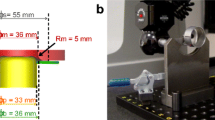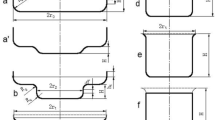Abstract
The paper describes an interactive computer aided analysis system for the simulation of the axisymmetric deep drawing process. The formulation is essentially based on the work of Woo; more emphasis, however, has been placed on the effect of the process and material variables such as the type of press (single-action with air or hydraulic cushions, double-action and hydraulic presses), tooling geometry, anisotropy, etc.
The material is assumed to be a rigid, strain hardening, anisotropic solid, and to obey the von Mises yield criterion. The present analysis is based on a membrane formulation, but accounts for the thinning due to bending under tension, in the manner of Swift.
The computer program is intended for the tooling and stamping industry. For a given set of process and material variables, the program CUPDRW calculates, at each movement of punch travel, the stresses and strains in each region of the deforming cup.
The program also evaluates the inner ram load, the outer ram load, and the total press tonnage. In addition, the program plots the thickness strain and thickness distribution in the final part, and based on these would calculate the part depth.
There is nothing new in the formulation, With the exception of modeling the blank holder conditions and the inclusion of thinning due to bending. Inputs to the program are easily executed and the numerical aspects are completely transparent to the user. A typical run using 300 ring elements in 18 steps of calculations would be 2–3 min on the 386-based machines.
CUPDRW has proved to be a good production and educational tool. CUPDRW provides the designer with quantitative insight as to the consequence of certain design decisions; such as changes in tool geometry, material properties, and the type of blank holder cycle.
Similar content being viewed by others
References
Chung, S.Y. and Swift, H.W.: “Cup-Drawing from a Flat Blank: Parts I and II,” Proc. Inst. Mech. Engrs., Vol. 165, pp. 199–228, 1951.
Woo, D.M.: “Analysis of the Cup-Drawing Process,”Int. J. Mech. Sci., Vol. 6, pp. 116–131, 1964.
Woo, D.M.: “The Analysis of Axisymmetric Forming of Sheet Metal and the Hydrostatic Bulging Process,”Int. J. Mech. Sci., Vol. 6, pp. 303–317, 1964.
Woo, D.M.: “On the Complete Solution of the Deep Drawing Problem,”Int. J. Mech. Sci., Vol. 10, pp. 83–94, 1968.
Hill, R.: “The Theory of the Yielding and Flow of Anisotropie Metals,” Proc. Roy. Soc., Vol. 193A, pp. 281–297, 1948.
Chiang, D.C. and Kobayashi, S.: “The Effect of Anisotropy and Work Hardening Characteristics on the Stress and Strain Distribution in Deep Drawing,” Trans. ASME,J. Engg. for Industry, Vol. 88, pp. 443–448, 1966.
Kaftanoglu, B. and Tekkaya, A.E.: “Complete Numerical Solutions of the Axisymmetric Deep Drawing Problem,” Trans ASME,J. Engg. Mats. Tech., Vol. 103, pp. 326–332, 1981.
Pope, M.H. and Berry, J.T.: “The Prediction of Press Loads in Deep Drawing with Various Conditions of Lubrication at Elevated Temperatures,” Trans. ASME,J. Engg. for Industry, Vol. 95, pp. 895–903, 1973.
Vemuri, K.R. Raghupathi, P.S. and Vu, P.H.: “A Computer Aided Design Sytem for Axisymmetric Deep Drawing Process,” pp. 101–121, NAMRC-XIV, Minneapolis, 1986.
Reissner, J. and Muller, A.: “CAD-CAM Combined Solution for Deep Drawing—A Case Study,” IDDRG Working Group Meeting, Amsterdam, The Netherlands, pp. 2–1 to 2–16, 23–24th May 1985.
Eshel, G., Barash, M.M. and Johnson, W.: “Automatic Generation of Process Outlines of Forming and Machining Processes,” ONR Final Report, Vol. 5, Purdue University, West Lafayette, Indiana, August 1986.
Tatenami, T., Nakamura, Y. and Saito, K.: “An Analysis of Deep Drawing Process Combined with Bending,” inNumerical Methods in Industrial Forming Processes, Pineridge Press, Swansea, U.K., pp. 687–696, 1982.
Swift, H.W.: “Plastic Bending Under Tension,”Engineering, Vol. 166, pp. 333–335, 357–359, 1948.
Emmens, W.C.: “Material Saving by Using a Varying Bank Holding Force,” IDDRG Working Group Meeting, Amsterdam, The Netherlands, pp. 7–1 to 7–5, 23–24th May 1985.
Manabe, K. and Nishimura, H.: “An Improvement in Deep Drawability of Steel/Plastic Laminate Sheet by Control of Blank Holding Force,” 2nd ITCP Conference, Stuttgart, Federal Republic of Germany, pp. 1297–1304, August 1987.
Karima, M. and Tse, W.: “A Computer Aided System for Draw Bead Analysis and Design,” to be published.
Karima, M.: “A Bifurcation Study of Wrinkling in Deep Drawing,” Ph.D. Thesis, McMaster University, Hamilton, Ontario, Canada 1981.
Triantafyllidis, N. and Needleman, A.: “An Analysis of Wrinkling in the Swift Cup Test,” Trans. ASME,J. Engg. Mats. Tech., Vol. 102, pp. 241–248, 1980.
Author information
Authors and Affiliations
Rights and permissions
About this article
Cite this article
Karima, M., Sowerby, R. A PC based computer aided analysis system for the cup drawing process. J. Mater. Shaping Technol. 6, 113–124 (1988). https://doi.org/10.1007/BF02834826
Issue Date:
DOI: https://doi.org/10.1007/BF02834826




